As an Amazon Associate I earn from qualifying purchases. This website also participates in other affiliate programs and may earn commissions if you shop through the links used on this website.
(This article was originally published on September 20, 2022 and was last updated on October 13, 2022)
Have you ever brought fresh basil into your kitchen and forgotten to use it for a day or two? When you finally pull it out to add to dinner, it is brown, black or wilted. This article explores how to store fresh basil to help its fresh flavor and gorgeous color last longer, testing out several popular methods before declaring the best!
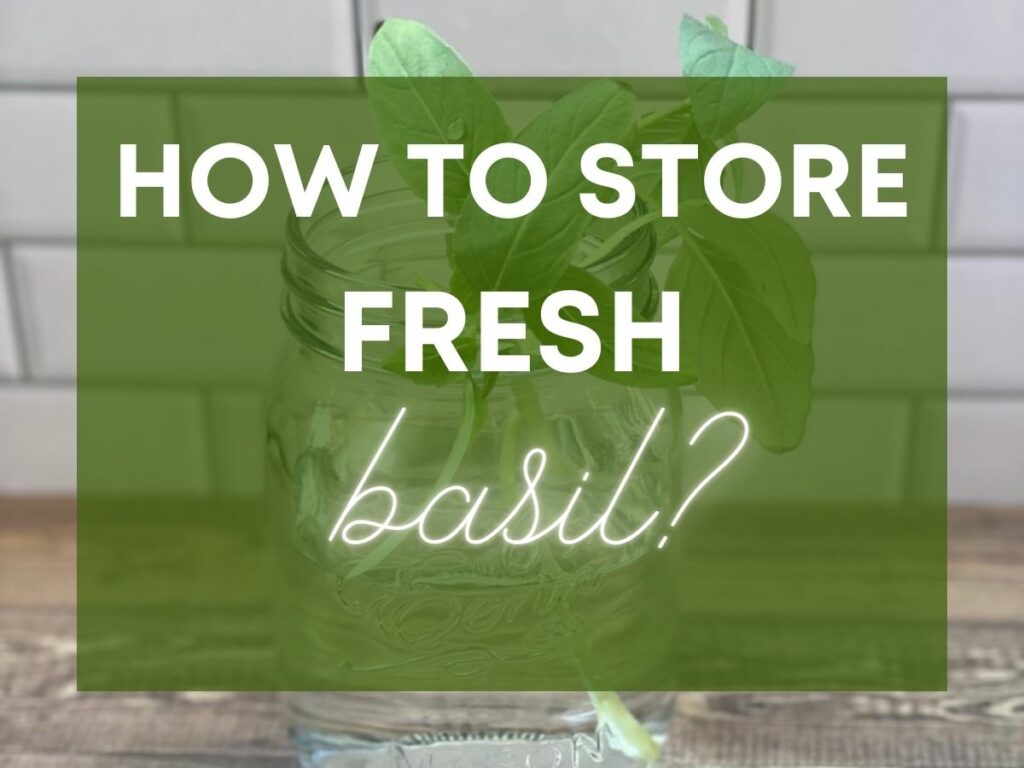
From pizza to pesto to homemade Thai food, fresh basil is one of the world’s most beloved culinary herbs. Sweet and spicy at the same time, adding fresh basil leaves to your cooking can bring a wonderful punch of flavor to your best kitchen creations.
But the joy of basil can quickly turn into disappointment when you reach for a few fresh basil leaves for dinner, only to discover they’ve wilted, turned brown, or turned black.
If you’ve ever wondered how to store and preserve fresh basil, this post is for you.
While there are a number of ways to store fresh basil, testing the different methods side-by-side yields a clear winner, which we’ve shared below.
Below, you’ll find a step-by-step guide to proper basil storage techniques to preserve your own fresh basil for longer.
It is an easy process that will help keep your kitchen counter stocked with fresh basil for whatever you’re cooking.
What’s the Best Way to Store Basil?
The best way to store basil is in a glass or jar filled with water, uncovered, on your counter top. Stored this way, basil will last for weeks, and possibly even months, and may even grow roots to propagate and entirely new plant. After testing 5 ways of storing fresh basil, I can confidently say simply putting a stem of basil in water and storing it uncovered at room temperature is the best way to store fresh basil. 24 days after putting this stem (pictured below) in water, it still looks fresh and has rooted.

Wondering How to Keep Basil Fresh After Cutting? Don’t Use the Jar in a Fridge Method.
Not all basil storage methods are created equal.
Despite some suggestions that you can store basil in the fridge in a sealed canning jar, this goes against the number one rule of storing fresh basil: keep it out of the fridge.
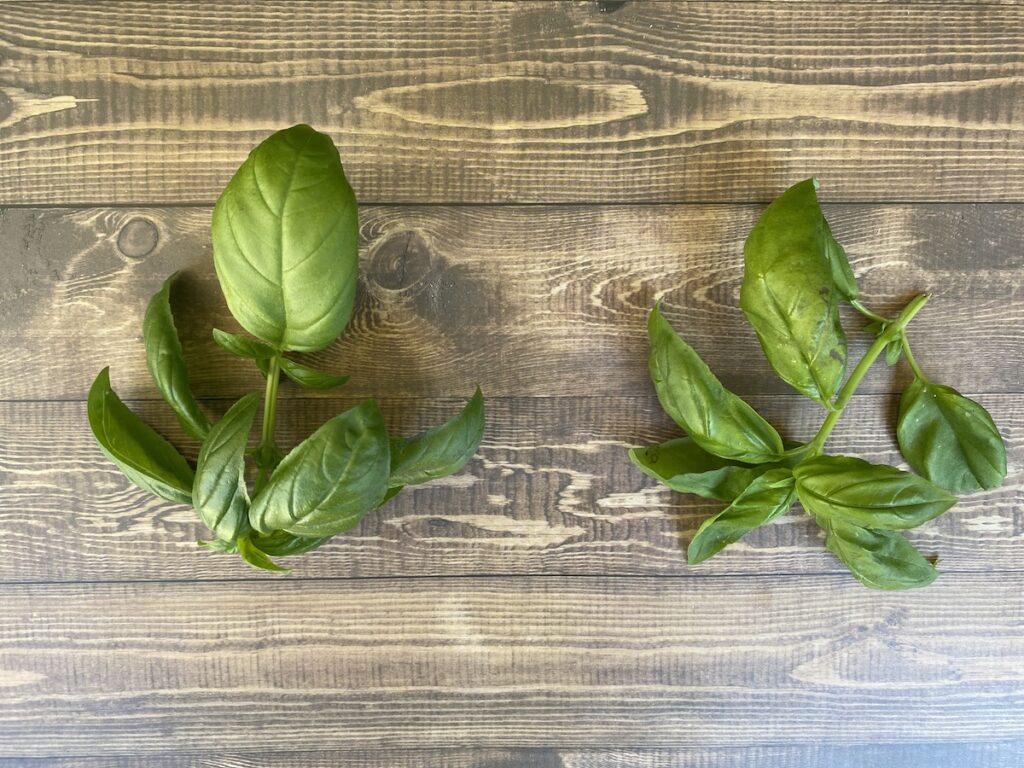
In fact, when we tested this method out, our basil leaves started to turn black within hours of putting them in the fridge.
Based on our personal experience, we don’t recommend this method.

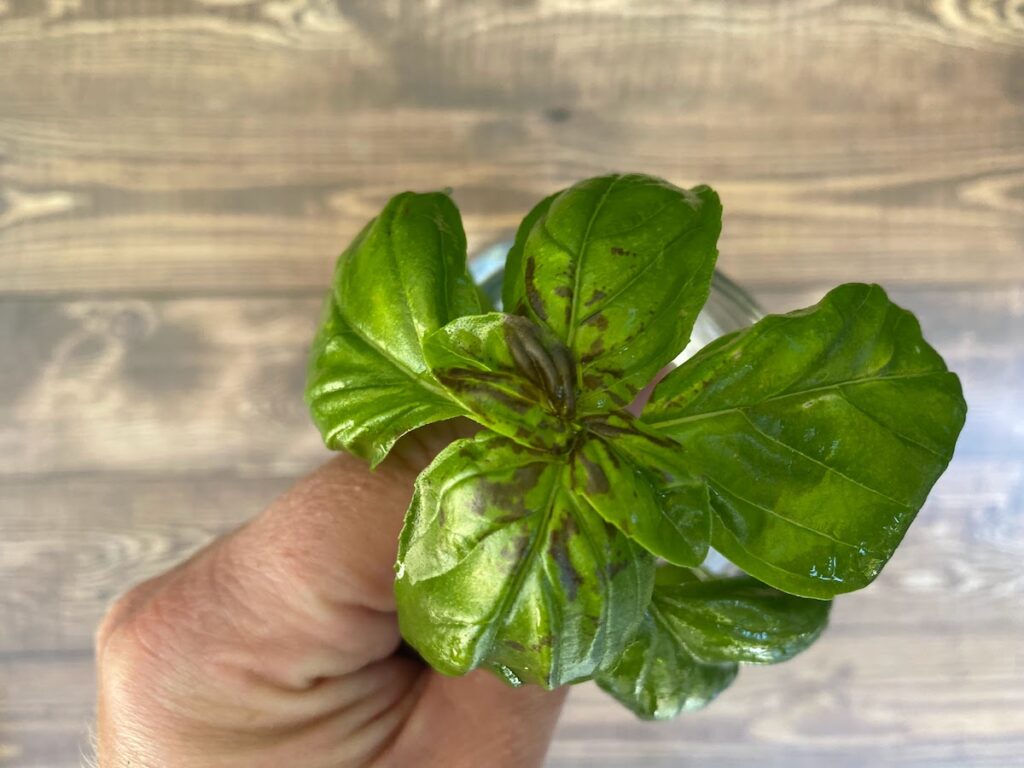
What’s the Best Way to Store Basil (to Keep it Fresh)?
The best way to preserve fresh basil is to keep the basil stem in fresh water, at room temperature, such as on your countertop, either uncovered or very loosely covered with a plastic bag.
By keeping the water topped up and occasionally trimming the stem, your fresh basil should last on your counter for a few weeks with this method. It may even sprout its own roots from the cutting – this has happened to us before!
Here’s the step-by-step on how to store your fresh basil using this method.
Select the Best Basil Leaves
Whether you purchase basil from the store or harvest from your own plants, take a few moments to inspect the basil leaves you’re about to store, and select the best leaves possible.
Look for strong, vibrant, and green leaves.
Avoid basil leaves that are starting to wilt, have slight brown tinges around the edges, or are yellowing.
Likewise, avoid obvious signs of disease such as white spots, or blackening.
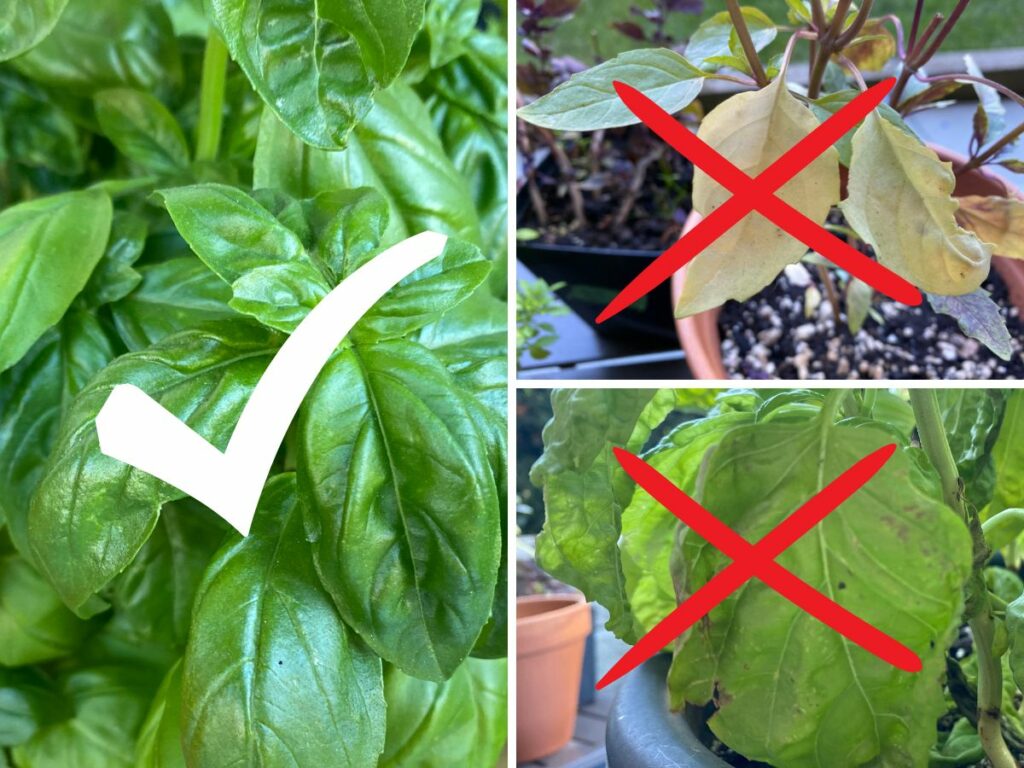
Selecting basil leaves with the best, healthiest overall appearance will prolong the life of your basil leaves when you do store them.
Only Store Basil Leaves Still Attached to the Stem
Additionally, ensure the basil leaves are still attached to the stem.
Having some stem is critical to properly storing fresh basil leaves (if you plan on drying or freezing your basil leaves, you can remove the stem).
If you are harvesting from your own plant, trim low enough on the plant to catch some of the stem along with the leaves, but always prune from the top down.
Now that you have selected your basil, you are ready to store it!
Trim the Stem Cuttings on a Diagonal
If you’re taking basil from your own plants, and popping them straight into water (see the next step), you might be able to skip this step.
But if you’re working with store bought, pre-trimmed basil stalks, you might notice the ends of your basil stems are a little rough. If that’s the case (likely), it means they’ve dried out due to air exposure. You need to trim this part off, otherwise the dried out stem end will prevent moisture from getting to the basil leaves.
Trimming basil stems is similar to how you trim cut flowers before putting them in a vase.
Cut the stems about a ½” (1.25cm) from the bottom using a pair of sharp kitchen or garden shears.
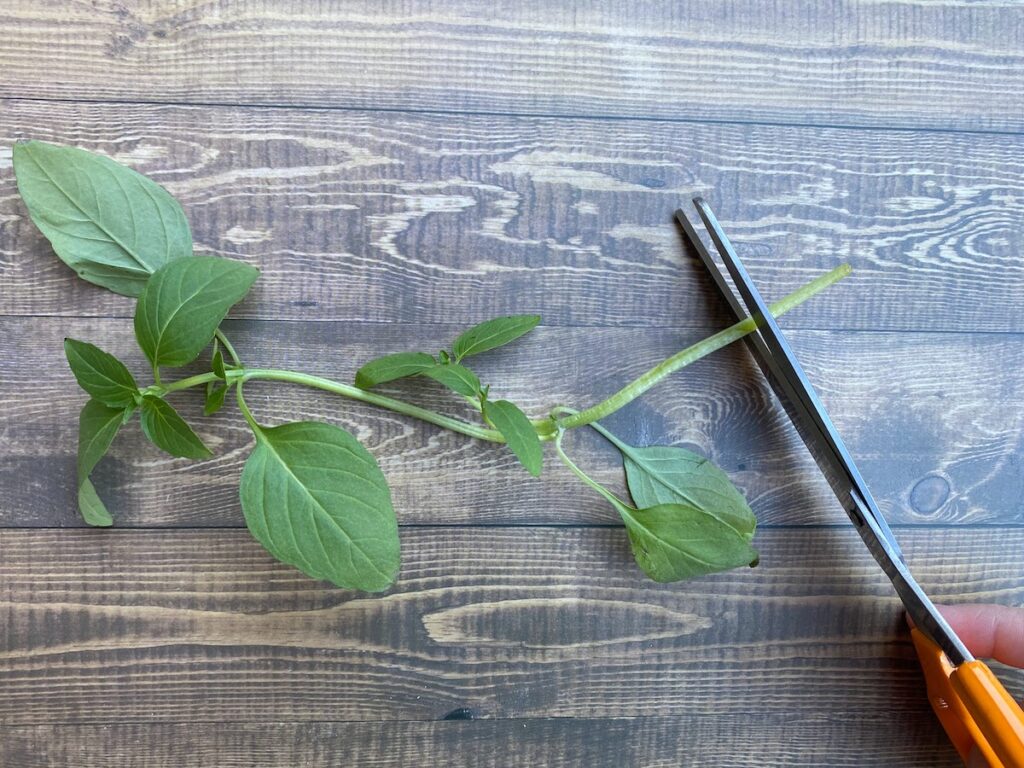
Cut on the diagonal rather than straight across. Trimming the stems at an angle provides more surface area for the water to access.

Add the Trimmed Fresh Basil Stems to Water
Select a small bowl, jar, or dish deep enough to hold a few inches of water.
Mason jars work great for storing fresh herbs, but shorter or taller water glasses, old clean jars, or other containers can work, too.
Fill the container with just enough to cover the stems about ¾ of the way up.
Be careful of the leaves. You want to keep them out of direct contact with the water, and may need to pinch-off lower leaves if they are sitting below the water line, or pour out a bit of water.
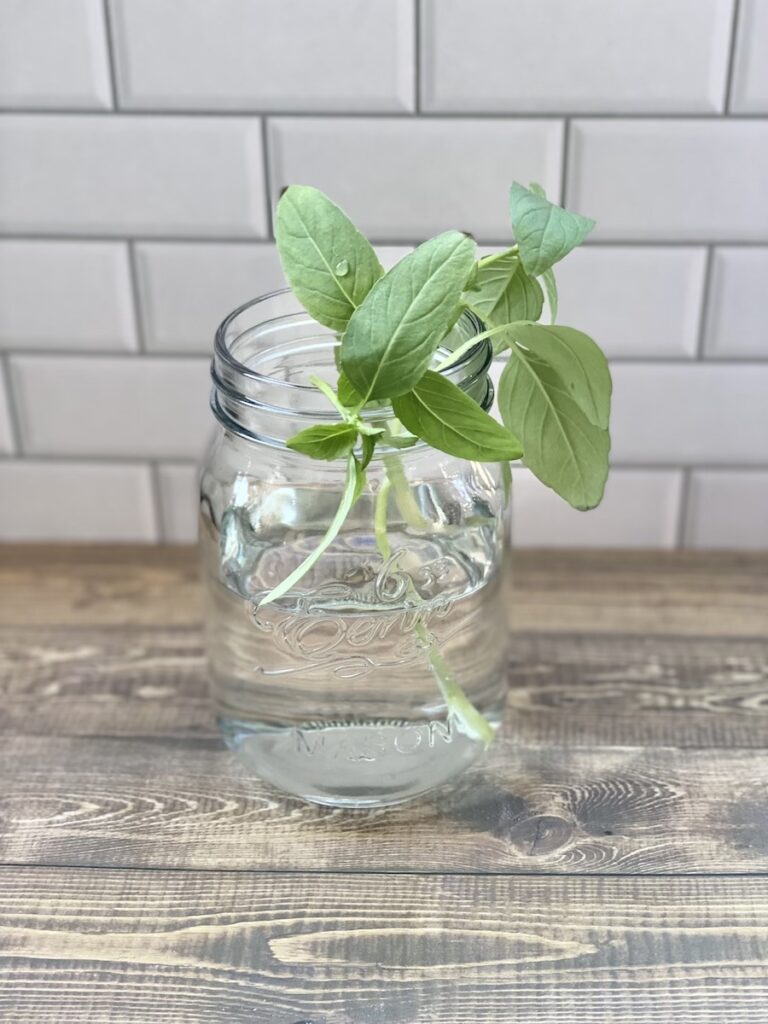
Optional: Cover the Leaves
This stage is optional, but I prefer not to cover basil. We’ve had lots of success storing fresh basil without covering it, and in our own tests, the plastic bag can actually damage the basil leaves.
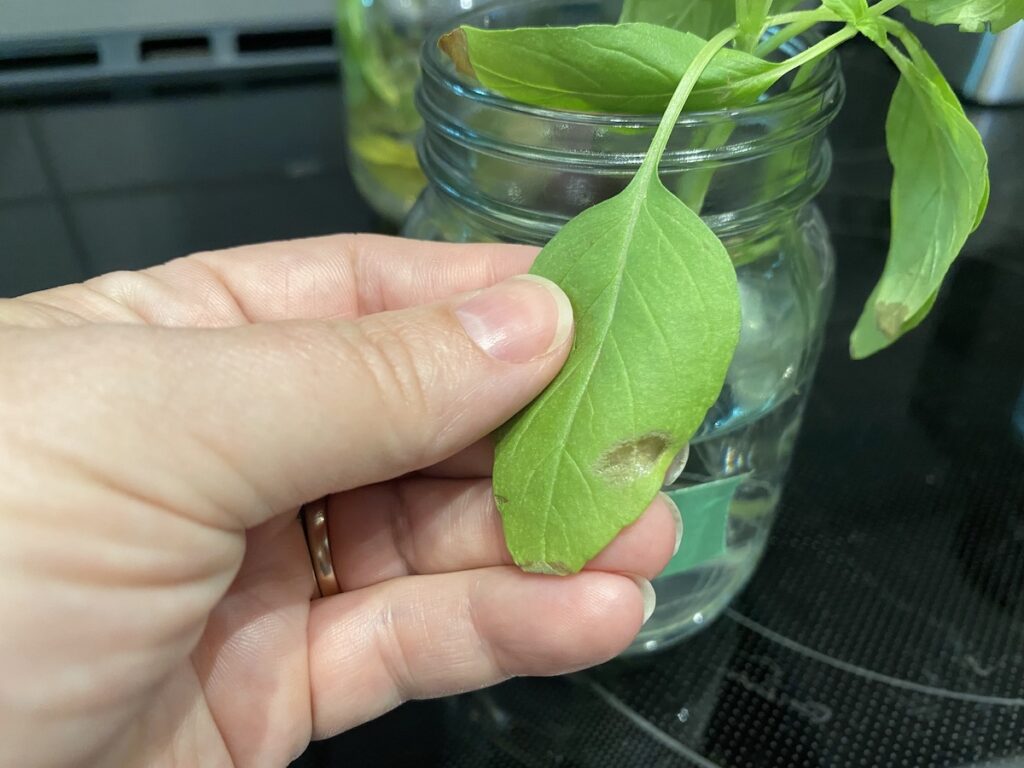
If you decide to cover your leaves, do so loosely with a plastic bag. A grocery bag from the produce section works well. As does any general storage bag you have lying around.
There are a few considerations to keep in mind:
- The bag should be clean and dry before you place it over your fresh basil.
- Don’t tie the bag down. Leave it loosely covering the basil, so it can still breathe.
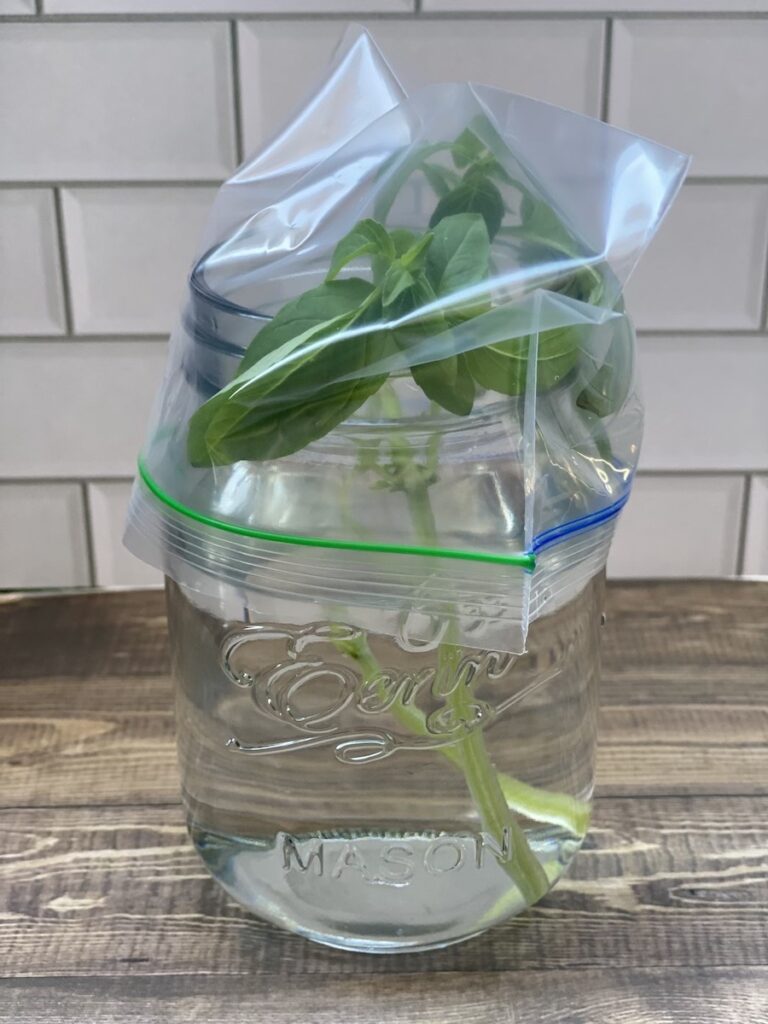
Out of curiosity, I also tried storing basil in water in a sealed mason jar. It actually help up pretty well for a few days, but 3.5 weeks later (the length of my test), and it’s looking pretty gross.
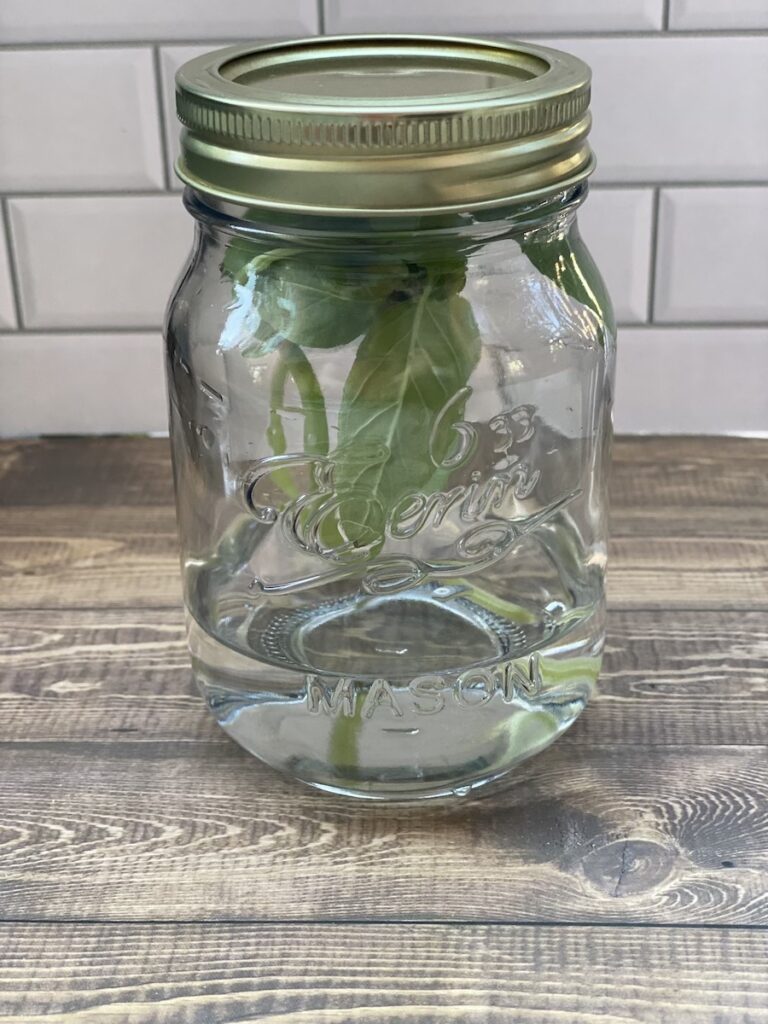

Step Four:
Once your basil is snugly situated in water and optionally covered up, leave it at room temperature. Putting fresh basil in the fridge is a surefire way to end up with black and wilted leaves.
Delicate basil leaves do not play nicely with cold temperatures and humidity in refrigerators.
Step Five:
Keep a close eye on your basil. You will likely need to refill or refresh the water at least once.
And that’s it! With just five simple steps, you have a supply of fresh basil ready at hand for all your cooking adventures. Fresh basil stored in this fashion will last up to 5-7 days or longer. The exact length of time will vary based on how fresh the leaves were to start with and the environment in your kitchen.
Alternative Ways to Store Fresh Basil
Are you short on counter or windowsill space? There are a few other storage options to consider.
Cold Storage
Storing your basil in the fridge is less than ideal. As discussed previously, this will result in rapidly diminishing quality. However, if you need to go this route, you should cut, wash, and dry your leaves. Then place them in a loosely fitting plastic bag before putting the bag in the fridge.
Note of Caution: Fresh basil leaves won’t last more than 2-3 days when stored in the fridge. You will want to use them up ASAP.
Turn it Into Pesto
For an alternative way to store your fresh basil, whip up a batch of pesto. Countless delicious recipes are floating around, all with a unique twist. Get started with this tasty version.
Pesto should last 3-5 days in the fridge (unless you eat it all first!) Or you can freeze it in ice cube trays for later use.
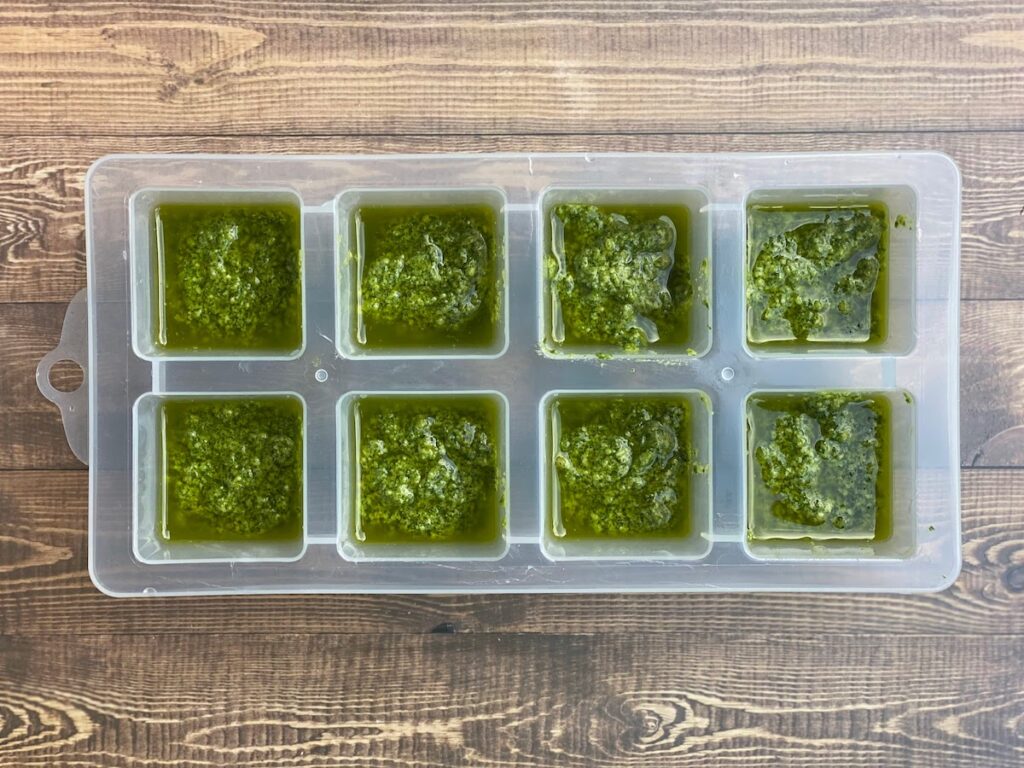
How Long Will My Basil Leaves Survive?
Generally, you can expect your fresh basil leaves to last approximately one week when stored properly. In ideal conditions, you may manage to keep the leaves for as long as two weeks.
How to Store Fresh Basil Leaves
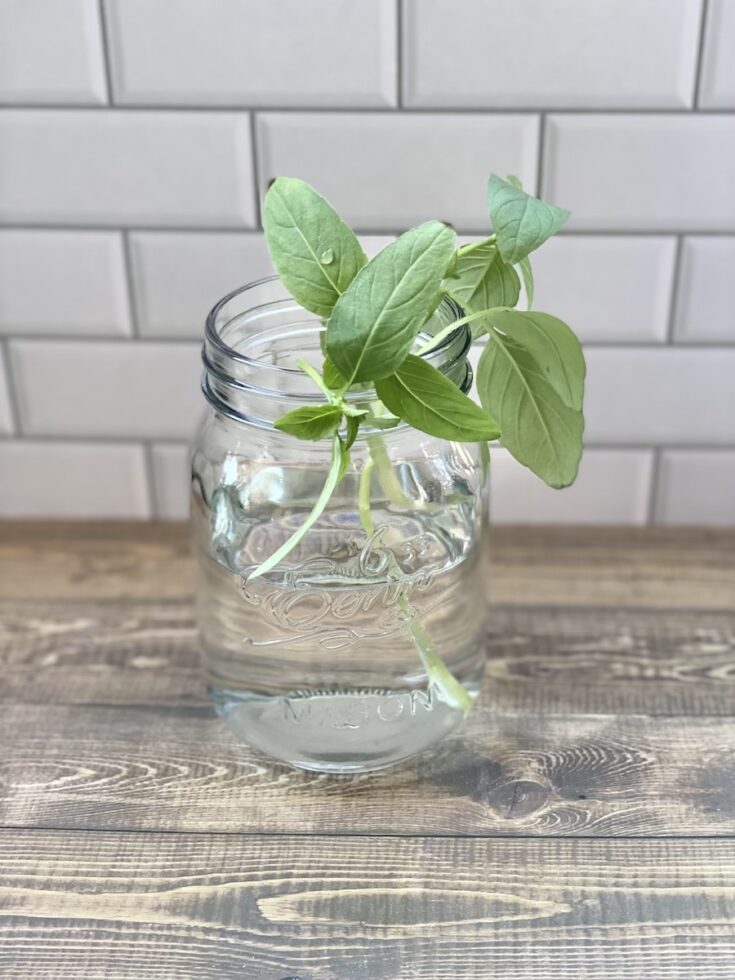
Have you ever watched with disappointment as your fresh basil leaves shrivel and wilt into a shadow of their former vibrant green glory? Follow these step by step instructions for how to store fresh basil so it stays fresh and delicious for longer.
Materials
- Stems of fresh basil, either from the supermarket or from your garden
- Kitchen scissors or garden sheers
- A glass jar, such as a mason jar
- Fresh water
- Optional: a clean plastic bag and/or mason jar lid
Instructions
- Before storing your fresh basil, make sure you're working with the best quality and healthy leaves possible. Select stems with vibrant green leaves that don't have any signs of disease or stress.
- Ensure the leaves you want to store are still attached to the stem.
- Trim the stems about a ½” (1.25cm) from the bottom using a pair of sharp kitchen or garden shears. Trim on a diaganol.
- Place the stem in a mason jar or other container, and fill with enough water to cover the stems about 3/4 of the way up, ensuring the leaves aren't sitting in the water. You can leave the basil like this at room temperature for a week or longer. The basil stem may start to develop roots, which means you've propagated a new basil plant from a cutting!
- Optional: cover the leaves loosely at the top with a clean plastic bag and leave on your counter at room temperature.
- Re-fill water as needed to ensure the stem is submerged.
Jennifer is a writer, Nutritionist, and Herbalist who loves all things food. She grows basil alongside other herbs and edible flowers in her garden. Herbs also hold a prominent space in her aerogarden. She enjoys experimenting in the kitchen, finding fun and unique ways to incorporate herbs into daily life. Jennifer is passionate about helping others discover the joy of quality food. And she loves to bring her two kids along on endless food adventures!

